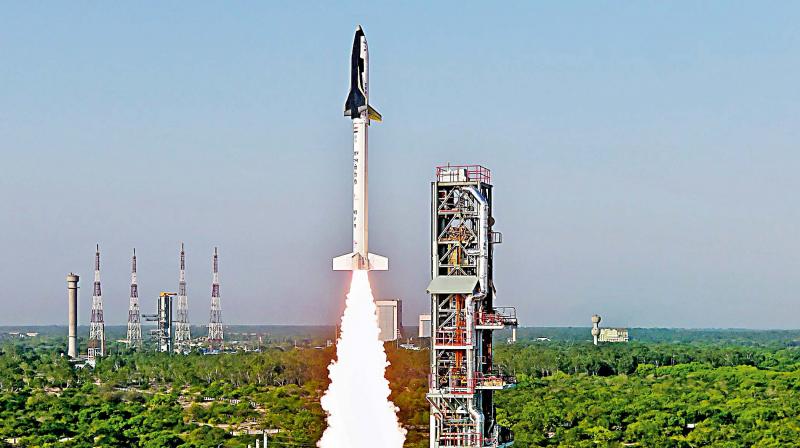ISRO has put up some nice images of its RLV-TD test flight:
http://www.isro.gov.in/rlv-td/rlv-take-videos-0
http://www.dw.com/en/india-launches-mini-space-shuttle/a-19277076
ISRO official K. Sivan said that the shuttle had survived the flight.I don't know if they're going to re-use the original flight article for the further tests, but the project is already plumbing the depths of cheapness, with a total cost so far of Rs.95 Crores (just over $14M USD) - and that includes the cost of constructing the building where RLV-TD was fabricated.
"We have located the place where the vehicle is floating. The landing was soft and the vehicle did not break," Sivan told the AFP news agency.
http://www.deccanchronicle.com/science/science/230516/isro-s-resusable-rocket-model-launch-today.html
UPDATE: Looks like the vehicle won't be recovered
http://www.newindianexpress.com/cities/chennai/ISROs-new-desi-reusable-wings-taste-success-in-maiden-flight/2016/05/24/article3448063.ece
Next month in June, India will be testing a scramjet engine (Supersonic Combustion Ramjet, designed to operate at hypersonic speeds in the thin upper atmosphere). It will be launched on a sounding rocket, and then activated as it picks up speed on the way down. Once that basic validation test has been completed, that scramjet engine will later eventually be mounted on the RLV-TD winged vehicle for its scramjet propulsion test (SPEX - the Scramjet Propulsion Experiment). Before that SPEX test occurs, 2 other tests must first occur. The RLV-TD will be fitted with landing gear and dropped from a transport plane to prove that it can land on a runway (LEX - the Landing Experiment). Next, RLV-TD will be fitted with a conventional turbojet engine and will take off from the runway, perform flight maneuvers and then return to land on the runway (REX - the Return flight Experiment). It is after LEX and REX have been done, that SPEX will go ahead: the RLV-TD will take off from a runway using a regular turbojet, then accelerate towards the upper atmosphere, and activate its scramjet engine to accelerate to hypersonic speed, before finally coming back down and landing on the runway like an ordinary aircraft.
ISRO's goal in doing these experiments, is to develop and build a reusable launch vehicle that can provide low-cost access to space. This vehicle itself is likely to have a progressive path - it will start out as a shuttle-style spaceplane that would be mounted on top of a large Solid Rocket Booster like the S-200 which is used in the GSLV Mark-III. This would enable the spaceplane - about 6 times larger than RLV-TD - to be launched to space, carrying satellites, and then later even astronauts after being man-rated. Eventually, that non-reusable solid rocket booster would be replaced with kerosene-burning rocket engines and/or a scramjet-powered flight stage.
Additionally, Dr Sivan has mentioned various cost-cutting ideas being looked at to make ISRO more competitive on launch costs in the near-medium term, due to the emergence of SpaceX as a powerful new competitor in the launch market:
http://thewire.in/2016/05/23/not-just-the-rlv-td-isro-has-more-plans-for-slashing-launch-costs-37943/
%20Images/rlv-tdtrialmock-upatshar-1.jpg)
%20Images/rlv-tdtrialmock-upatshar-2.jpg)


No comments:
Post a Comment